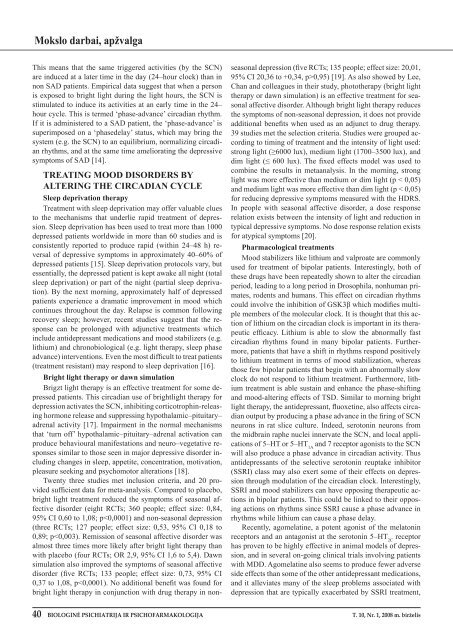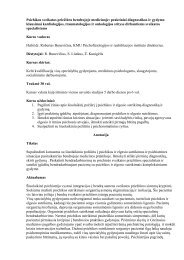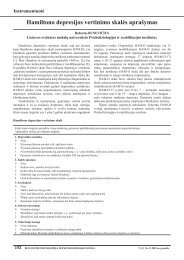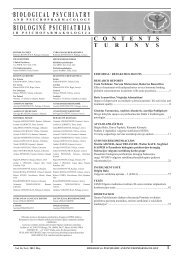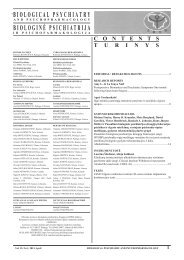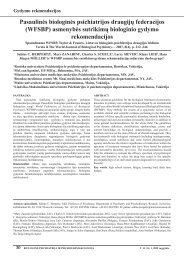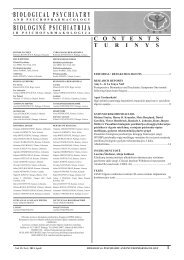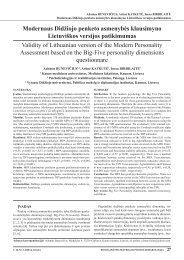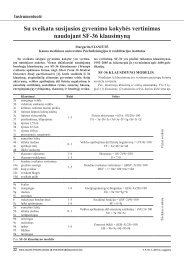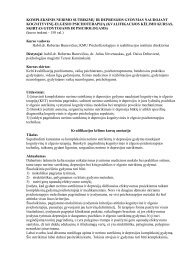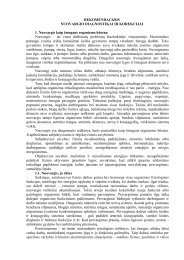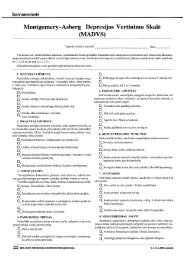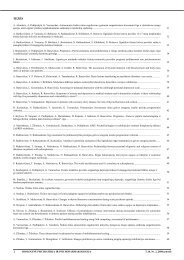V<strong>ir</strong>ginija Adomaitienė, Darius Leskauskas, Gediminas KuncaDepression symptoms: significance of the c<strong>ir</strong>cadian rhythms. Review of literatureA diagnosis of CRSD can be made under certain conditions.F<strong>ir</strong>st, the disorder must be accompanied by insomnia,excessive sleepiness or both, with social/occupational impa<strong>ir</strong>mentor jeopardizing other areas. Second, the pattern of thedisorder should be persistent or recurrent. Finally, the causeshould be either an alteration in the timing mechanism or thelack of synchronization between the endogenous c<strong>ir</strong>cadianrhythm and exogenous factors that affect the hours or the durationof sleep [9].In order to help prevent disruptions in the c<strong>ir</strong>cadian sleepcycle it is important to maintain a regular sleep schedule,which includes ret<strong>ir</strong>ing and waking at approximately the sametime each day, and sleeping a consistent number of hours eachnight. This is especially important for people with morningnesstendencies because the<strong>ir</strong> c<strong>ir</strong>cadian cycles are less adaptableto changes in behavior.C<strong>ir</strong>cadian rhythm and mood disordersFor many years it is considered that abnormalities in c<strong>ir</strong>cadianrhythms may underlie the development of mood disorderssuch as bipolar disorder (BPD), major depression andseasonal affective disorder (SAD). Furthermore, some of thetreatments that are currently employed to treat mood disordersare thought to act by shifting or “resetting” the c<strong>ir</strong>cadian clock,including total sleep deprivation (TSD) and bright light therapy.There is also reason to suspect that many of the mood stabilizersand antidepressants used to treat these disorders mayexhibit at least some of the<strong>ir</strong> therapeutic efficacy by affectingthe c<strong>ir</strong>cadian clock. Recent genetic, molecular and behavioralstudies implicate individual genes that make up the clock inmood regulation. As well, important functions of these genesin brain regions and neurotransmitter systems associated withmood regulation are becoming apparent. Current evidenceabout the linkage between c<strong>ir</strong>cadian rhythms and mood disorders,underlying biological factors of these relationships ispresented in the review by McClung and colleagues [3].The c<strong>ir</strong>cadian rhythms act like a multifunctional timerto adjust the homeostatic brain system, including sleep andwakefulness, locomotor activity, to approximately 24-h cycle,and allow organisms to adapt to env<strong>ir</strong>onmental changes. Differentparadigms can be used to explain the disruptions of thec<strong>ir</strong>cadian rhythms, including chronic constant light exposure(CCL), phase shifting of the light–dark cycle, bilateral lesionsof the master clock in the suprachiasmatic nucleus and clockgene mutant, etc. Among these paradigms, CCL is a simple,chronic way to influence c<strong>ir</strong>cadian rhythms which may occurduring shift work, hospital intensive care units or futurespace travel. Furthermore, evidence suggests that disruptionof biological rhythms increases plasma corticosterone levels,and evokes stress. Stress is defined as adaptive syndromes inresponse to negative life-events and tactically indicated byplasma levels of glucocorticoids [1].Seasonal Affective DisorderIn recent years psychiatrists have recognized the impact ofseasonal changes on mood and behavior. Seasonal affectivedisorder (SAD) is a unipolar mood disorder in which patientsare highly responsive to the total amount of light availablein the env<strong>ir</strong>onment [10]. SAD, characterized by recurring falland winter depressions (with remissions during spring andsummer), affects approximately 5% of the population [11].SAD is not recognized as a distinct disorder in ICD–10, butit is included in DSM–IV as recurrent mood disorder withseasonal pattern. Individuals who suffer from seasonal affectivedisorder show signs of depression during the fall andwinter months when there are less hours of natural sunlight.Disturbances in mood are the main psychological componentof seasonality [12]. Persons suffering from seasonal depressiongenerally show an increase in appetite and hypersomnia,which oddly is opposite of the behavior normally associatedwith most other forms of depression. This behavior is consistentwith research conducted on animals and may be related tobasic survival instincts. The explanation behind this theory isthat people like some animals may have a natural tendencytowards increasing fat stores in the body during the winter, aswell as sleeping more often in order to preserve energy levels.Several more recent studies suggest that suffers of seasonal affectivedisorder display disturbances in the<strong>ir</strong> c<strong>ir</strong>cadian cycles,as indicated by less consistent rhythm patterns. A commontherapy used to treat seasonal affective disorder is light exposuretherapy [10]. Though the effects of light exposure are notcompletely understood it has been shown that the presences ofeither natural or artificial light seems to work towards correctingc<strong>ir</strong>cadian disturbances caused by seasonality.Symptoms of seasonal depressionThe characteristic feature is the recurrent episodes of depressionwith an onset in autumn or winter, and remission overthe spring and summer months. Features shared with non-seasonaldepression include:• low mood (often worst in the morning)• anhedonia• low libido• <strong>ir</strong>ritability• impa<strong>ir</strong>ed concentration.Features more specific to SAD than non-seasonal depressioninclude:• hypersomnia (often with prominent daytime sleepinessand fatigue)• chocolate/carbohydrate craving• weight gain.These symptoms have given rise to analogies with hibernationand may have been advantageous at an earlier stage ofman’s development [13].The pathophysiology of SAD is not fully understood, althoughit is assumed to be associated with altered c<strong>ir</strong>cadianrhythms. Basic c<strong>ir</strong>cadian rhythms are regulated by several endogenousor exogenous pacemakers. The major endogenouspacemaker is probably located in the suprachiasmatic nucleus(SCN) of the hypothalamus. One of the major exogenouspacemakers is the light–dark cycle, in which different durationsof light or dark hours affect the timing of sleep induction,hormone secretion, and many other biological rhythms.In healthy, euthymic subjects, the ratio of light to dark hourstriggers the SCN to induce certain activities, including sleep,hormone secretion, and the secretion of melatonin via stimulatingthe pineal gland. SAD is characterized, among otherthings, by a basic state of ‘phase-delay’ c<strong>ir</strong>cadian rhythm.T. 10, Nr. 1, 2008 m. b<strong>ir</strong>želisBiologinė <strong>psichiatrija</strong> <strong>ir</strong> psichofarmakologija39
Mokslo darbai, apžvalgaThis means that the same triggered activities (by the SCN)are induced at a later time in the day (24–hour clock) than innon SAD patients. Emp<strong>ir</strong>ical data suggest that when a personis exposed to bright light during the light hours, the SCN isstimulated to induce its activities at an early time in the 24–hour cycle. This is termed ‘phase-advance’ c<strong>ir</strong>cadian rhythm.If it is administered to a SAD patient, the ‘phase-advance’ issuperimposed on a ‘phasedelay’ status, which may bring thesystem (e.g. the SCN) to an equilibrium, normalizing c<strong>ir</strong>cadianrhythms, and at the same time ameliorating the depressivesymptoms of SAD [14].Treating mood disorders byaltering the c<strong>ir</strong>cadian cycleSleep deprivation therapyTreatment with sleep deprivation may offer valuable cluesto the mechanisms that underlie rapid treatment of depression.Sleep deprivation has been used to treat more than 1000depressed patients worldwide in more than 60 studies and isconsistently reported to produce rapid (within 24–48 h) reversalof depressive symptoms in approximately 40–60% ofdepressed patients [15]. Sleep deprivation protocols vary, butessentially, the depressed patient is kept awake all night (totalsleep deprivation) or part of the night (partial sleep deprivation).By the next morning, approximately half of depressedpatients experience a dramatic improvement in mood whichcontinues throughout the day. Relapse is common followingrecovery sleep; however, recent studies suggest that the responsecan be prolonged with adjunctive treatments whichinclude antidepressant medications and mood stabilizers (e.g.lithium) and chronobiological (e.g. light therapy, sleep phaseadvance) interventions. Even the most difficult to treat patients(treatment resistant) may respond to sleep deprivation [16].Bright light therapy or dawn simulationBrigzt light therapy is an effective treatment for some depressedpatients. This c<strong>ir</strong>cadian use of brightlight therapy fordepression activates the SCN, inhibiting corticotrophin-releasinghormone release and suppressing hypothalamic–pituitary–adrenal activity [17]. Impa<strong>ir</strong>ment in the normal mechanismsthat ‘turn off’ hypothalamic–pituitary–adrenal activation canproduce behavioural manifestations and neuro–vegetative responsessimilar to those seen in major depressive disorder includingchanges in sleep, appetite, concentration, motivation,pleasure seeking and psychomotor alterations [18].Twenty three studies met inclusion criteria, and 20 providedsufficient data for meta-analysis. Compared to placebo,bright light treatment reduced the symptoms of seasonal affectivedisorder (eight RCTs; 360 people; effect size: 0,84,95% CI 0,60 to 1,08; p
- Page 1 and 2: ISSN 1648-293XB i o l o g i n ė p
- Page 3 and 4: Redakcijos skiltisDepresijos gydyma
- Page 5 and 6: Mokslo darbaiĮVADASDidėjant serga
- Page 9: Mokslo darbaidažnį tarp 35-74 m.
- Page 13 and 14: Mokslo darbaiSergančiųjų koronar
- Page 15 and 16: Mokslo darbaiFizinis krūvis, W90,0
- Page 17 and 18: Mokslo darbaiFizinis nuovargis paci
- Page 19 and 20: Mokslo darbaiPaskutinių metų duom
- Page 21 and 22: Mokslo darbaiLITERATŪRA:1. Rozansk
- Page 23 and 24: Mokslo darbaitarpu dėl hipoksijos
- Page 25: Mokslo darbaiΔRR B, ms ΔRR B, %
- Page 28 and 29: Adomas Bunevičius, Arūnė Katkut
- Page 30 and 31: Adomas Bunevičius, Arūnė Katkut
- Page 32 and 33: Enigma of Bipolar depressionBipolin
- Page 34 and 35: Elmārs RancānsEnigma of Bipolar d
- Page 36 and 37: Elmārs RancānsEnigma of Bipolar d
- Page 38 and 39: Virginija Adomaitienė, Darius Lesk
- Page 42 and 43: Virginija Adomaitienė, Darius Lesk
- Page 44 and 45: Rainald Mössner, Olya Mikova, Elen
- Page 46 and 47: Rainald Mössner, Olya Mikova, Elen
- Page 48 and 49: DisertacijosA.Deksnytės daktaro di


